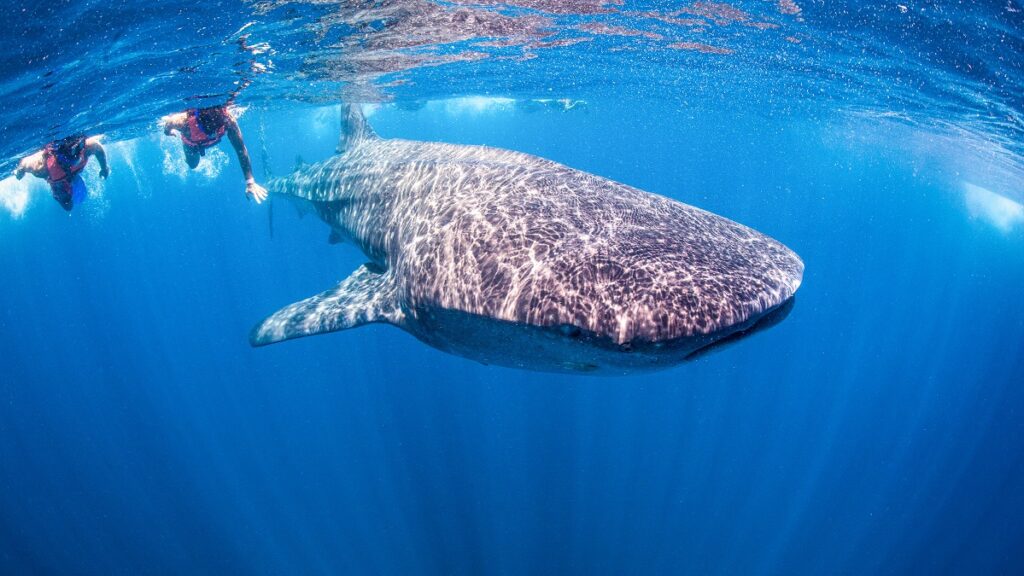The water, which is normally turquoise blue, is dark and slightly forbidding because of cloud cover. It’s actually raining, not that rain is upsetting for fish, and it’s windy.
I’m in Exmouth in the Ningaloo region in Western Australia, snorkelling and looking at a whale shark.
My wife and I are booked with a charter group called Kings Ningaloo Reef Tours. There are a handful of charter operators and some use small planes to look for the whale sharks.
Unfortunately today, because of the rain clouds, they haven’t been able to get over the range so the captain, Bill, is driving around in circles, as are the other charter boats, looking for them.
Bingo. He’s found one – minutes before the spotter planes get airborne due to a break in the clouds – and in we jump, 20 paid customers divided into two groups due to regulations, under the direction of two crew members.
There are instructions, such as no diving and stay in line with your team leader’s raised arm. The intention is that the whale shark will swim past you, but in all the excitement I’ve let my group get away.
I turn, looking for the whale shark, and find myself looking into its mouth. It’s just metres away and swimming straight at me.
To find myself here shouldn’t have been the shock it was. After all, seeing a whale shark is the very reason I’d paid $475 to be on this boat. I just didn’t expect the whale shark to be so close or to get in its way.
I get moving and swim to the side. The boat’s photographer grabs me by the hand and pulls me forward. You’re not supposed to get ahead of the whale shark and if you swim alongside you must stay behind its dorsal fin, because if it sees you, it might dive out of sight. No-one wants that.
This one is tolerant and our group follows it for several minutes.
Then we spot another behind it, just swimming along, minding its own business and we follow it before our team leader decides the boat is getting too far away and back we go.
And that, for me, is day over. We’ve had several false starts – in and out of the water because a whale shark had decided to dive –and I found that process rather tiring. Besides, I’m cold. The air temperature is only 18°C (the water is warmer) and the wind is biting – even in a full-length wetsuit. Most of the others keep going, and going.
I’d estimate there were five opportunities to swim with the whale sharks, plus two snorkels and a rare chance to be in the water with a whale – though at a considerable distance. On the way back, there’s another opportunity to dive on the reef but I’ve spent the past few days snorkelling my way along the Ningaloo coast and, to be honest, I’m happy.
There are no guarantees you’ll get to swim with these gentle giants, but we’ve been lucky.
For me, this day wasn’t a bucket-list item. It was for my wife, so I went along. And I enjoyed it more than she did. She gets seasick, so it was hard work. I don’t, and I also got to look a whale shark in the eyes while she had to settle for glimpses from metres away.
Two days later, a host of photos are emailed to us. There’s one of somebody who looks like me but I’m not really sure so I won’t be framing it. They are fabulous photos though and they’re part of the package, along with morning tea and lunch and hot and cold drinks. The clarity of the images is amazing and the white markings on the whale sharks seem to be almost electric.
Swimming with whale sharks will mean different things to different people but you will never know what it means to you if you don’t do it.
What you should know
The whale shark tours are available from March/April to July.
We were picked up from our accommodation at 7.15am and returned by about 4pm. The boats leave from Tandabiddi Boat Ramp, about 30 minutes from Exmouth. The bus ride was a great time to learn about the history of the area.
The amazingly energised crew keep you safe, informed and entertained. Safety instructions are paramount early and there’s much to learn about whale sharks. They can grow up to 18 metres and are here to feed. We’re reminded that they’re filter feeders and are harmless to humans. But of course they are big!
We were given a full-length wetsuit, flippers, snorkel and mask, though some took their own equipment.
We first did a snorkel over a coral reef on the outside of the lagoon – perhaps to check people’s abilities.
Noodles and life vests were provided to anyone who wasn’t confident.
There are rules about how many people can be in the water at any one time, so we were divided into two groups and took turns when whale sharks were spotted. In for 10 minutes and out for 10, then back in and so on.
There is a raincheck system in place if no whale sharks are spotted. Just read the T&Cs.
If you think you might get seasick, take some medication. The crew are not allowed to hand out tablets and by then, it’s probably too late.
Try to wear something so you can spot yourself easily in the photographs. Otherwise everyone can look pretty similar.
Finally, book early. We were unsure about when we’d be in Exmouth and got a shock at the limited number of spots available.
What bucket list experience stands tall in your memory? Why not share it in the comments section below?
Read also: The Nullarbor – beast or beauty?

